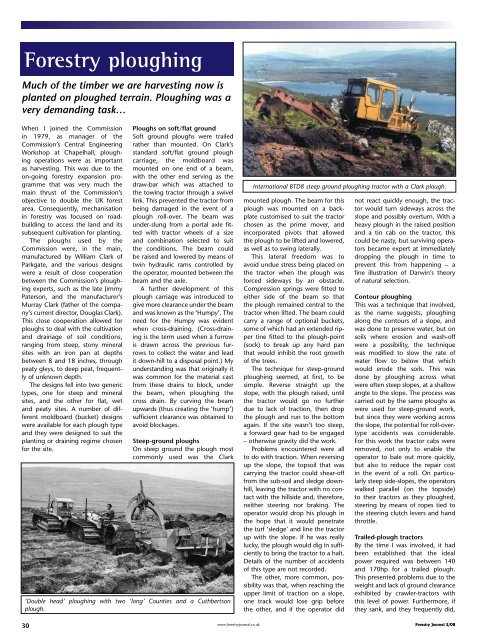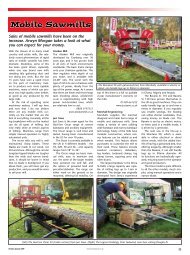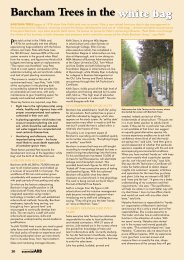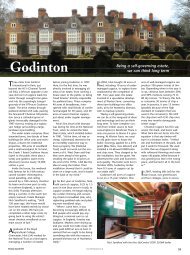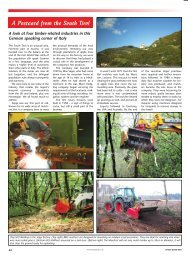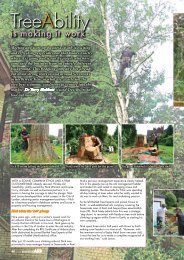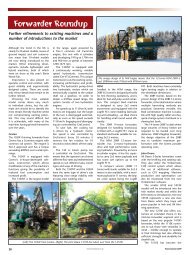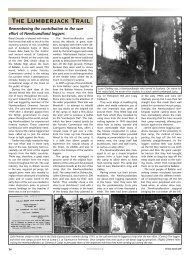Forestry ploughing - Forestry Journal
Forestry ploughing - Forestry Journal
Forestry ploughing - Forestry Journal
- No tags were found...
Create successful ePaper yourself
Turn your PDF publications into a flip-book with our unique Google optimized e-Paper software.
<strong>Forestry</strong> <strong>ploughing</strong>Much of the timber we are harvesting now isplanted on ploughed terrain. Ploughing was avery demanding task…When I joined the Commissionin 1979, as manager of theCommission’s Central EngineeringWorkshop at Chapelhall, <strong>ploughing</strong>operations were as importantas harvesting. This was due to theon-going forestry expansion programmethat was very much themain thrust of the Commission’sobjective to double the UK forestarea. Consequently, mechanisationin forestry was focused on roadbuildingto access the land and itssubsequent cultivation for planting.The ploughs used by theCommission were, in the main,manufactured by William Clark ofParkgate, and the various designswere a result of close cooperationbetween the Commission’s <strong>ploughing</strong>experts, such as the late JimmyPaterson, and the manufacturer’sMurray Clark (father of the company’scurrent director, Douglas Clark).This close cooperation allowed forploughs to deal with the cultivationand drainage of soil conditions,ranging from steep, stony mineralsites with an iron pan at depthsbetween 8 and 18 inches, throughpeaty gleys, to deep peat, frequentlyof unknown depth.The designs fell into two generictypes, one for steep and mineralsites, and the other for flat, wetand peaty sites. A number of differentmoldboard (bucket) designswere available for each plough typeand they were designed to suit theplanting or draining regime chosenfor the site.Ploughs on soft/flat groundSoft ground ploughs were trailedrather than mounted. On Clark’sstandard soft/flat ground ploughcarriage, the moldboard wasmounted on one end of a beam,with the other end serving as thedraw-bar which was attached tothe towing tractor through a swivellink. This prevented the tractor frombeing damaged in the event of aplough roll-over. The beam wasunder-slung from a portal axle fittedwith tractor wheels of a sizeand combination selected to suitthe conditions. The beam couldbe raised and lowered by means oftwin hydraulic rams controlled bythe operator, mounted between thebeam and the axle.A further development of thisplough carriage was introduced togive more clearance under the beamand was known as the ‘Humpy’. Theneed for the Humpy was evidentwhen cross-draining. (Cross-drainingis the term used when a furrowis drawn across the previous furrowsto collect the water and leadit down-hill to a disposal point.) Myunderstanding was that originally itwas common for the material castfrom these drains to block, underthe beam, when <strong>ploughing</strong> thecross drain. By curving the beamupwards (thus creating the ‘hump’)sufficient clearance was obtained toavoid blockages.Steep-ground ploughsOn steep ground the plough mostcommonly used was the Clark‘Double head’ <strong>ploughing</strong> with two ‘long’ Counties and a Cuthbertsonplough.International BTD8 steep ground <strong>ploughing</strong> tractor with a Clark plough.mounted plough. The beam for thisplough was mounted on a backplatecustomised to suit the tractorchosen as the prime mover, andincorporated pivots that allowedthe plough to be lifted and lowered,as well as to swing laterally.This lateral freedom was toavoid undue stress being placed onthe tractor when the plough wasforced sideways by an obstacle.Compression springs were fitted toeither side of the beam so thatthe plough remained central to thetractor when lifted. The beam couldcarry a range of optional buckets,some of which had an extended rippertine fitted to the plough-point(sock) to break up any hard panthat would inhibit the root growthof the trees.The technique for steep-ground<strong>ploughing</strong> seemed, at first, to besimple. Reverse straight up theslope, with the plough raised, untilthe tractor would go no furtherdue to lack of traction, then dropthe plough and run to the bottomagain. If the site wasn’t too steep,a forward gear had to be engaged– otherwise gravity did the work.Problems encountered were allto do with traction. When reversingup the slope, the topsoil that wascarrying the tractor could shear-offfrom the sub-soil and sledge downhill,leaving the tractor with no contactwith the hillside and, therefore,neither steering nor braking. Theoperator would drop his plough inthe hope that it would penetratethe turf ‘sledge’ and line the tractorup with the slope. If he was reallylucky, the plough would dig in sufficientlyto bring the tractor to a halt.Details of the number of accidentsof this type are not recorded.The other, more common, possibilitywas that, when reaching theupper limit of traction on a slope,one track would lose grip beforethe other, and if the operator didnot react quickly enough, the tractorwould turn sideways across theslope and possibly overturn. With aheavy plough in the raised positionand a tin cab on the tractor, thiscould be nasty, but surviving operatorsbecame expert at immediatelydropping the plough in time toprevent this from happening – afine illustration of Darwin’s theoryof natural selection.Contour <strong>ploughing</strong>This was a technique that involved,as the name suggests, <strong>ploughing</strong>along the contours of a slope, andwas done to preserve water, but onsoils where erosion and wash-offwere a possibility, the techniquewas modified to slow the rate ofwater flow to below that whichwould erode the soils. This wasdone by <strong>ploughing</strong> across whatwere often steep slopes, at a shallowangle to the slope. The process wascarried out by the same ploughs aswere used for steep-ground work,but since they were working acrossthe slope, the potential for roll-overtypeaccidents was considerable.For this work the tractor cabs wereremoved, not only to enable theoperator to bale out more quickly,but also to reduce the repair costin the event of a roll. On particularlysteep side-slopes, the operatorswalked parallel (on the topside)to their tractors as they ploughed,steering by means of ropes tied tothe steering clutch levers and handthrottle.Trailed-plough tractorsBy the time I was involved, it hadbeen established that the idealpower required was between 140and 170hp for a trailed plough.This presented problems due to theweight and lack of ground clearanceexhibited by crawler-tractors withthis level of power. Furthermore, ifthey sank, and they frequently did,30www.forestryjournal.co.uk<strong>Forestry</strong> <strong>Journal</strong> 3/08
the subsequent debogging exercisewas expensive and time consuming.The solution that evolved was touse two tractors, preferably identical,of about 70hp each, with a rearmountedwinch. The lead tractor’sline was attached to the secondtractor – to which the plough wasattached on a short line. This combinationgave a number of optionsin the event of the plough becomingstuck: one or both tractors couldmove independently to find gripbefore pulling the plough throughthe obstructing patch. If the leadtractor became stuck then it couldwinch itself out using the secondtractor and plough as an anchor.With the development of goodteamwork, the unit seldom becomeso bogged that a third unit had tobe brought in and although thisworking method required two meninstead of one, the overall cost peracre was reduced.Although a range of differentmakes and models of tractor waspurchased for this task, the mostcommonly used was based on theInternational BTD8 – with what wascalled a Bowen 60 conversion. Thiskit was sold by Bowen International’sScottish agent, who developed thekit for use on the early version of theBTD8 when they were rated at 60hp– hence the name – but the samekit was also used after the tractorwas upgraded to 70hp. The kit wasessentially an extended track-framewhich, although it gave the tractora bigger footprint, did not generatea proportionally greater pull. Thiswas because the track was extendedforward and, when the tractorwas pulling, the weight transferredbackwards, causing the front of thetractor to rise out of contact withthe ground.A second kit was developed toovercome this problem, and atChapelhall, where the kit was manufacturedand fitted, many BTD8swere successfully converted. Theywere known as the CEW 70. This wasmore effective as the kit droppedthe sprocket downwards and backwards,increasing ground clearancewhile allowing the track-frame to beextended both backwards and forwards,producing a well-balancedmachine with exceptional groundclearance, for a tractor of is power.Domestic problemsThe problems that arose, from this‘double headed’ system of working,were not engineering ones,but domestic ones. It was commonpractice for operators of machines,working in remote areas to live inClark trailed single-furrow ploughs with double throw moldboards, fitted with cage wheels, belonging to DalgleishBrothers of Moffat.caravans through the week – goinghome only at weekends. Where twomen were working on the same site,additional savings on their costscould be made by their sharing acaravan. This required very carefulselection when pairing operatorssince these men were living andworking in very cramped quartersfor long periods of time. The beststories cannot be put on paper, buta fairly typical ‘domestic altercation’that I had to deal with arosewhen one of the team insisted onboiling his socks and underwearin the same pot that was used formaking the porridge. Apparently,he saw nothing unhygienic aboutthis and claimed that he gave thepot, “A guid rinse oot eftir billin’ma claze.”DeboggingTo the best of my knowledge, theCommission has never left a unitunderground, but I know for a factthat many of the debogging exerciseshave cost more than the valueof the machine being retrieved.One of the first problems commonlyencountered when a machinesank was that the only parts of themachine visible were not robustenough to attach a rope to. Thepull-hooks,as supplied by the manufacturer,are usually under the noseof the unit, on the belly-plate. Whena machine is sunk in a slurry of peatand freezing-cold water, how doyou shackle a heavy-duty sling tothe hook that is five-feet under thesurface? The answer is you don’t– you attach it before it sinks. Oncethis was realised, all <strong>ploughing</strong> tractorsand machines, where sinkingwas a possibility, were fitted, immediatelyon delivery from the manufacturer,with a strop – one end ofwhich was permanently attachedto the pull-hook and the other toa bracket on top of the bonnet, orother such mounting, high on thesuperstructure.Very few machines require tobe debogged as a result of normalusage. Inevitably, expensive deboggingexercises resulted from poorlyexecuted attempts at a quick-fix.Machines stuck in wet areas areheld by suction: the faster you pullthe more pull you will require. Usethe slowest pull-speed and the forceneeded will be surprisingly low. Atwo-tonne hand-winch will debog amachine that a ten-tonne, line-pullwinch cannot move.Steep-ground tractorsA wide range of crawler-tractorswere suitable for this purpose. Thebasic requirements were for about70 to 100hp and a back-end thatcould easily be adapted to mountthe plough. Normally, if the fixeddraw-bar was removed, the mountingholes could be picked up andused to mount the plough. Tracksdid not have to be too long sincesteep <strong>ploughing</strong> was, more oftenthan not, on firm ground. Providedthe track plates were sufficientlyaggressive, there was no need tofit anything other than standardgrouser plates.With the weight of the ploughA bogged Cat D4 awaits rescue.on the rear of the tractor, it wasideal for reversing up slopes – andto prevent the front from being toolight when running empty, frontmounted,hydraulic winches werefitted, both as ballast and to give ameans of self-rescuing if a problemarose.The future for ploughs?Currently, most commercial plantingis done on clearfelled sites,but, in response to the worldwideupsurge in demand for timber,there is a likelihood that forestrymay have to spread ‘downhill’ ontomarginal grazing land. Were this tohappen, it is unlikely that we willrevert to <strong>ploughing</strong> as a means ofground preparation. To understandthe reason for this we only haveto ask, “Why plough a great longfurrow when we only stick a tree inevery metre along its length?”As for <strong>ploughing</strong> amongst treestumps for restocking, we tried that:it ruins both machines and men,does not produce good plantingsites, and is more expensive thanthe methods currently being used.Jim ChristiePicture courtesy of Jim McVittie<strong>Forestry</strong> <strong>Journal</strong> 3/08 www.forestryjournal.co.uk31


